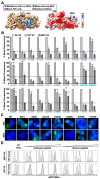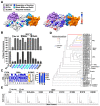Evolutionary Conservation of PP2A Antagonism and G2/M Cell Cycle Arrest in Maedi-Visna Virus Vif
- PMID: 36016323
- PMCID: PMC9413702
- DOI: 10.3390/v14081701
Evolutionary Conservation of PP2A Antagonism and G2/M Cell Cycle Arrest in Maedi-Visna Virus Vif
Abstract
The canonical function of lentiviral Vif proteins is to counteract the mutagenic potential of APOBEC3 antiviral restriction factors. However, recent studies have discovered that Vif proteins from diverse HIV-1 and simian immunodeficiency virus (SIV) isolates degrade cellular B56 phosphoregulators to remodel the host phosphoproteome and induce G2/M cell cycle arrest. Here, we evaluate the conservation of this activity among non-primate lentiviral Vif proteins using fluorescence-based degradation assays and demonstrate that maedi-visna virus (MVV) Vif efficiently degrades all five B56 family members. Testing an extensive panel of single amino acid substitution mutants revealed that MVV Vif recognizes B56 proteins through a conserved network of electrostatic interactions. Furthermore, experiments using genetic and pharmacologic approaches demonstrate that degradation of B56 proteins requires the cellular cofactor cyclophilin A. Lastly, MVV Vif-mediated depletion of B56 proteins induces a potent G2/M cell cycle arrest phenotype. Therefore, remodeling of the cellular phosphoproteome and induction of G2/M cell cycle arrest are ancient and conserved functions of lentiviral Vif proteins, which suggests that they are advantageous for lentiviral pathogenesis.
Keywords: HIV-1; MVV; PPP2R5; Vif; host-pathogen; phosphatase regulation.
Conflict of interest statement
The authors declare no conflict of interest.
Figures




Similar articles
-
Functional and Structural Insights into a Vif/PPP2R5 Complex Elucidated Using Patient HIV-1 Isolates and Computational Modeling.J Virol. 2020 Oct 14;94(21):e00631-20. doi: 10.1128/JVI.00631-20. Print 2020 Oct 14. J Virol. 2020. PMID: 32847850 Free PMC article.
-
Maedi-visna virus Vif protein uses motifs distinct from HIV-1 Vif to bind zinc and the cofactor required for A3 degradation.J Biol Chem. 2021 Jan-Jun;296:100045. doi: 10.1074/jbc.RA120.015828. Epub 2020 Nov 24. J Biol Chem. 2021. PMID: 33465707 Free PMC article.
-
Critical role of PP2A-B56 family protein degradation in HIV-1 Vif mediated G2 cell cycle arrest.Biochem Biophys Res Commun. 2020 Jun 18;527(1):257-263. doi: 10.1016/j.bbrc.2020.04.123. Epub 2020 May 4. Biochem Biophys Res Commun. 2020. PMID: 32446377
-
Demystifying Cell Cycle Arrest by HIV-1 Vif.Trends Microbiol. 2021 May;29(5):381-384. doi: 10.1016/j.tim.2021.01.001. Epub 2021 Jan 19. Trends Microbiol. 2021. PMID: 33478820 Free PMC article. Review.
-
Host restriction of lentiviruses and viral countermeasures: APOBEC3 and Vif.Viruses. 2013 Jul 30;5(8):1934-47. doi: 10.3390/v5081934. Viruses. 2013. PMID: 23903287 Free PMC article. Review.
Cited by
-
Defining the Protein Phosphatase 2A (PP2A) Subcomplexes That Regulate FoxO Transcription Factor Localization.Cells. 2025 Feb 27;14(5):342. doi: 10.3390/cells14050342. Cells. 2025. PMID: 40072071 Free PMC article.
-
Single-cell delineation of strain-specific HIV-1 Vif activities using dual reporter sensor cells and live cell imaging.J Virol. 2025 Mar 18;99(3):e0157924. doi: 10.1128/jvi.01579-24. Epub 2025 Feb 25. J Virol. 2025. PMID: 39998123 Free PMC article.
-
Inhibition of ATM-directed antiviral responses by HIV-1 Vif.PLoS Pathog. 2023 Sep 5;19(9):e1011634. doi: 10.1371/journal.ppat.1011634. eCollection 2023 Sep. PLoS Pathog. 2023. PMID: 37669285 Free PMC article.
References
Publication types
MeSH terms
Substances
Grants and funding
LinkOut - more resources
Full Text Sources

